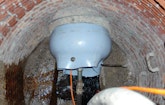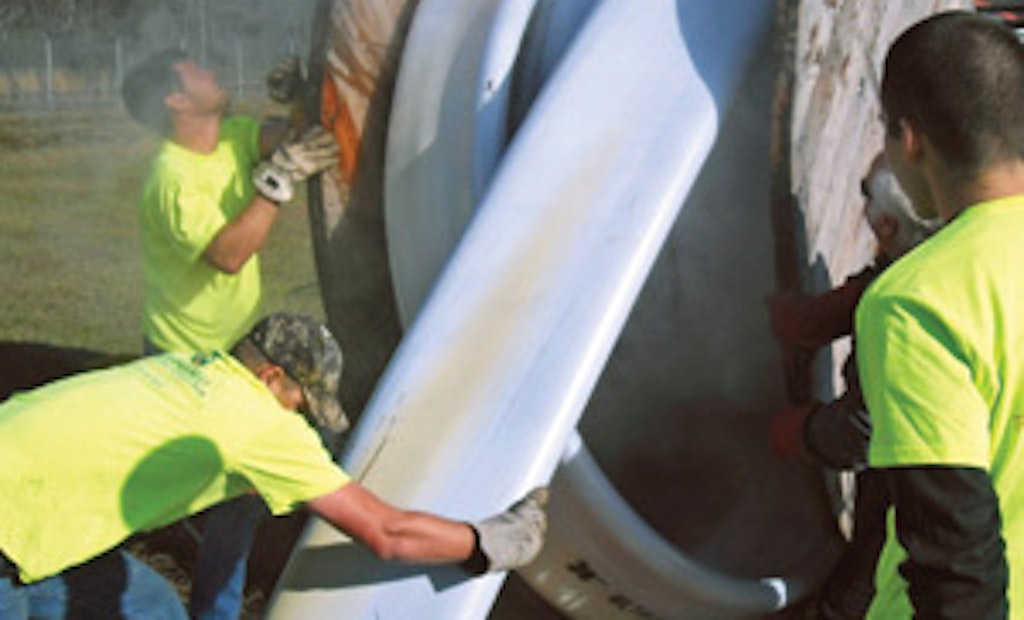Interested in Cleaning?
Get Cleaning articles, news and videos right in your inbox! Sign up now.
Cleaning + Get AlertsA heavily tuberculated, flaking and rusting 90-foot section of 18-inch carbon steel pipe in a 280-foot clay pipe sewer was a headache for the City of Titusville, Fla.
Waste hung up on the tuberculation, causing stoppages that belched sewage up two 15-foot-deep manholes in the center turn lane of a major four-lane highway. Daily cleaning and jetting to open the line caved in the crown, inundating the wastewater treatment plant with mud, sand, and infiltration, as the pipe was below the water table.
Vibrations from passing traffic loosened more soil, creating a void that began migrating well below the asphalt toward a railroad track crossing the highway. If the void reached the tracks, the city feared it would undermine the bed. Continued cleaning brought down more sections of pipe, blocking the jetter.
About the only things preventing a depression or hole in the center lane were the communication and fiberoptic cables, gas lines, and water mains running above the sewer. Open cutting was out of the question, and the city bid specified that lining products had to withstand a gritty, semi-live pipe.
Engineered Lining Systems (ELS) Inc. in Jacksonville, Fla., won the contract. It overcame all obstacles by using a custom PVC alloy thermoforming pipe lining system that rehabilitated the sewer in three hours.
What a mess
A camera inspection revealed that the clay pipe had minor imperfections, but tuberculation in the carbon steel section under the tracks had constricted its diameter to 3 inches. Work proceeded from dusk through dawn when the traffic and hydraulic flow were lightest.
A city crew plugged the upstream manhole, then used the other deep manholes on the line as storage capacity, enabling six ELS workers to jet the line. “The city monitored the manholes, releasing the pressure three or four times a night when they were full,” says ELS president Don Arch.
The crew parked its equipment in the turn lane and worked from the downstream manhole. Traffic was never affected. The men used Lumberjack high-speed, low-torque multipurpose chain cutters from NozzTeq Inc. and a GapVax combination truck to clean the pipe. They regulated flow and pressure as needed, avoiding damage to the fragile metal.
“Although we were very delicate, sections of pipe still failed, pinning the cutter and jetter,” says Arch. “When that happened, we’d launch another jetter from the upstream manhole to wash off the mud and free the trapped tools.” The men cleaned 12 to 14 hours a day for four days, much longer than Arch anticipated.
After they removed 90 percent of the tuberculation, Jeff Wayner, Public Works field operations superintendent, reviewed the tapes and decided it was time to line the pipe. “The more we cleaned, the greater the risk of catastrophic failure and having to excavate,” says Arch.
All or nothing
The SDR35 PVC alloy pipe from UltraLiner arrived from the factory in Oxford, Ala., coiled on a wooden spool and folded like an H lying on its side. Arch notes that the liner could not simply be pulled off the spool because the alloy has a memory and would coil up again. The material must be heated and softened first.
“We formed a tent over the reel with a tarp and introduced steam from a boiler truck through a pipe into the center of the spool for about an hour,” says Arch. The hole, acting like a chimney, dispersed steam at 280 degrees F upward and over the liner until it was limp.
While the liner heated, the men pulled a 1/2-inch winching cable through the pipe. When the liner was pliable, they tapered the head to prevent snagging in the sewer. They then drilled two opposing holes 12 inches in from the edge, fed a chain through the holes, and hooked it to a 30-ton hydraulic winch. It pulled the liner through the pipe at 40 to 50 feet per minute.
The crew sealed the upstream end tightly against the manhole with a flow-through sewer plug from Plug-It Products, then connected the steam hose. The heat relaxed the alloy and prevented post-installation longitudinal shrinkage. The crew then plugged the downstream end and increased the boiler pressure to 8 psi to inflate the liner.
“Using the correct amount of pressure was critical, as too much would have expanded the liner through the numerous gaps and ruptured it,” says Arch. After the liner formed to the pipe, they reduced the pressure to 4 psi to hold it in place as an after-cooler blew in 80-degree compressed air.
When the temperature at the exhaust end of the liner dropped below 100 degrees, the crew turned off the pressure and allowed the liner to cure for two hours. If a mistake had occurred in the process or placement, they could have reheated the liner, applied a vacuum with the combination truck to collapse it, extracted it, corrected the error and reinserted the liner.
The sewer plugs flared out the ends of the liner against the manholes, locking them in place and preventing inflow and infiltration. To combat the head pressure at 12 feet below the water table, a worker applied hydrophilic rubber seals to fill any remaining annular spaces between the liner and manhole, then coated them with Epoxytec Concrete Polymer Paste.
“We started pulling at 2 a.m. and the line was completely rehabilitated by 5 a.m.,” says Arch. “That’s a very quick turnaround.” The crew’s final inspection of the pipe showed that the liner had formed itself to a slick surface even where the original crown was missing.
Parting shot
When workers laid the sewer in the 1930s, they shored up the trench with wooden cribbing, and it was still there. All the I&I and jetting had washed away much of the surrounding soil, creating a huge void around the pipe.
“The city had resurfaced the highway the previous year and didn’t want to risk a cave-in,” says Arch. “We called Henderson Wilder Company in Orlando to stabilize the soil and highway.” Two days of pumping grout removed the threat of collapse.








